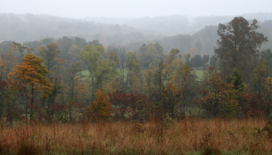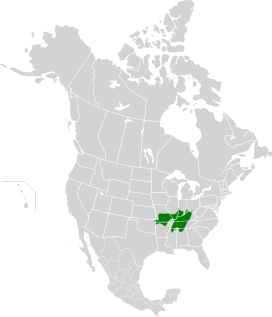Central U.S. hardwood forests facts for kids
The Central U.S. hardwood forests are a special type of forest found in the Eastern United States. They are called an ecoregion, which means they are a large area with similar plants, animals, and climate. The World Wide Fund for Nature (WWF) describes these forests. They are known for having many different kinds of herbaceous plants, which are plants without woody stems, like wildflowers.
Quick facts for kids Central U.S. hardwood forests |
|
|---|---|

Hoosier National Forest
|
|
 |
|
| Ecology | |
| Realm | Nearctic |
| Biome | Temperate broadleaf and mixed forests |
| Borders |
List
|
| Bird species | 203 |
| Mammal species | 69 |
| Geography | |
| Area | 296,000 km2 (114,000 sq mi) |
| Country | United States |
| States | |
| Conservation | |
| Habitat loss | 46.522% |
| Protected | 7.01% |
Contents
Where are the Central U.S. Hardwood Forests?
This is a very large area. It mostly has gently rolling plains. But there are also some higher areas. These include the Ozark plateau and other plateaus in Kentucky and Tennessee.
One amazing place here is Mammoth Cave National Park. It has a huge system of sandstone caves. The climate in this inland area is usually quite dry.
What Plants Live Here?
Before Europeans arrived, this region had many oak savannas. These were open grasslands with scattered oak and hickory trees. There were also thick woodlands and forests.
Today, only small parts of these oak and hickory woodlands are left. You can also find trees like dogwoods, sassafras trees, and hop hornbeams. This ecoregion also has large areas of prairie, which are natural grasslands. There are also wetter meadows. These meadows are home to tall tulip trees and sweetgums.
What Animals Live Here?
Many different animals call these forests home. Birds like vireos and tanagers fly through the trees.
Mammals you might see include bobcats, white-tailed deer, and Eastern gray squirrels. You can also find chipmunks, raccoons, and opossums living here.
What Challenges Do These Forests Face?
Long ago, oak trees were very common here because of frequent natural fires. These fires helped clear out other plants. But since the 1930s, people have stopped many fires. This has changed the forests a lot.
Today, very little of the original forest is left untouched. For example, 70 to 95 percent of the bottomland hardwood forests are gone. Also, only a tiny part (0.02 percent) of the original oak savannas remain.
Even though much of the area is still forested, these forests are often broken up into small pieces. They have also been changed by buildings, farms, and the lack of fires. Oak and hickory trees are still common. But other trees like maples and yellow poplars are growing underneath them. This makes it hard for new oak trees to grow.
Some areas are also threatened by cities growing bigger. Invasive species are also a problem. These are non-native plants that spread quickly. Examples include non-native privet, honeysuckle, garlic mustard, and kudzu.
Important Natural Areas
Despite the challenges, there are still many important natural areas in this ecoregion. These include:
- The Wolf River (Tennessee)
- The Cedar glades and the western Highland Rim in Tennessee
- Mammoth Cave National Park
- The Land Between the Lakes National Recreation Area in Tennessee and Kentucky
- Hoosier National Forest and Yellowwood State Forest in southern Indiana
- The Edge of Appalachia Preserve in Ohio
- The Cache River (Illinois) wetlands and the Shawnee Hills in southern Illinois
- The Ozarks in Missouri, including Mark Twain National Forest
The best-preserved areas are Mammoth Cave, Edge of Appalachia, parts of the Missouri Ozarks, and the Tennessee Cedar Glades.

